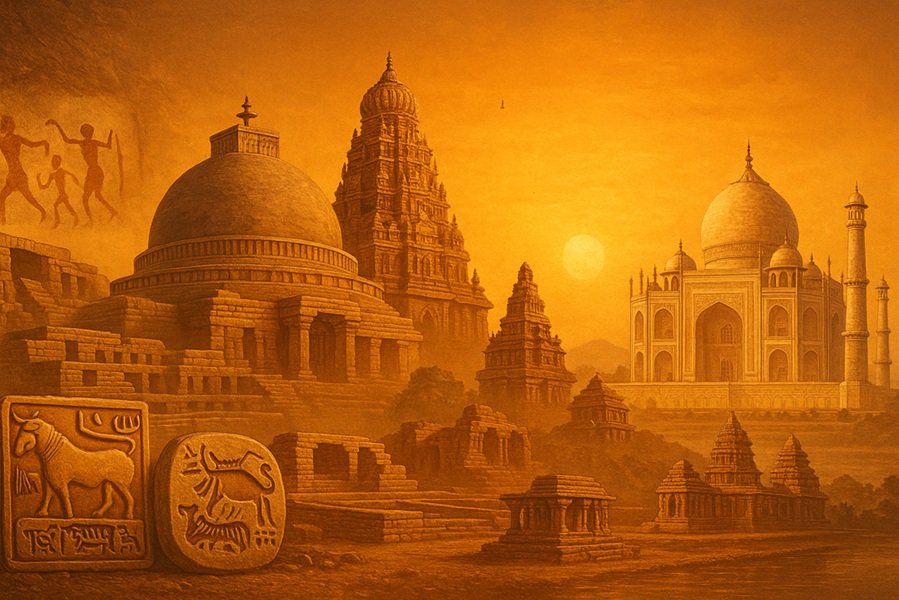
Introduction
India, one of the world’s oldest civilizations, is a living museum of history. Beneath its soil lie layers of ancient kingdoms, forgotten cities, sacred temples, and lost cultures that continue to reveal new insights into human evolution and societal development. From the Indus Valley Civilization to the Mauryan, Gupta, Chola, and Mughal eras, India’s archaeological sites offer an unparalleled timeline of human ingenuity, faith, and artistic expression.
These sites are not mere ruins — they are chronicles of civilization, documenting India’s transition from prehistory to a sophisticated cultural superpower.
1. The Indus Valley Civilization: Foundations of Urban Life
Key Sites: Harappa (Punjab, Pakistan) and Mohenjo-Daro (Sindh, Pakistan), and Indian sites like Dholavira and Lothal (Gujarat), Kalibangan (Rajasthan), Rakhigarhi (Haryana).
Dating back to 2500 BCE, the Indus Valley Civilization (IVC) was one of the earliest urban cultures in the world — contemporary with Egypt and Mesopotamia. Excavations reveal:
- Planned cities with advanced drainage systems, public baths, and standardized bricks.
- Trade networks connecting Mesopotamia and Persia.
- Artifacts like seals, pottery, and figurines depicting daily life and spirituality.
Analysis
The IVC challenges the notion that ancient societies were primitive. The urban planning at Dholavira and port system at Lothal prove that early Indians mastered engineering, maritime trade, and civic management — a remarkable achievement 4,500 years ago.
2. Buddhist Heritage: Monastic Architecture and Spiritual Evolution
Key Sites: Sanchi (Madhya Pradesh), Nalanda and Vikramshila (Bihar), Ajanta and Ellora Caves (Maharashtra), Bodh Gaya (Bihar).
After the life of Gautama Buddha (6th century BCE), India became a center for Buddhist art and philosophy.
- Sanchi Stupa (3rd century BCE, built by Ashoka) is one of the earliest stone structures in India, symbolizing peace and enlightenment.
- Ajanta Caves (2nd century BCE – 6th century CE) display intricate murals narrating Jataka tales.
- Nalanda University, one of the world’s oldest centers of learning, attracted scholars from China, Tibet, and Southeast Asia.
Analysis
These sites illustrate how India shaped global spirituality and education. The artistic refinement in Buddhist caves shows an advanced understanding of aesthetics, geometry, and storytelling — proving that ancient Indian artisans were not mere builders but philosophers and scientists of form.
3. The Mauryan and Gupta Periods: Political Power and Artistic Refinement
Key Sites: Sarnath, Pataliputra (Patna), Udayagiri Caves (Madhya Pradesh), and the Iron Pillar (Delhi).
During Ashoka’s Mauryan Empire (3rd century BCE), art and architecture became political tools to express Dharma (righteous rule). The Ashokan Pillars, carved from a single stone, reflect precision and craftsmanship unmatched for centuries.
The Gupta Period (4th–6th century CE), known as the “Golden Age of India,” saw the rise of refined temple architecture — as seen in Deogarh’s Dashavatara Temple — and classical sculpture.
Analysis
These eras mark the birth of India’s architectural grammar — symmetry, proportion, and symbolism — which would later influence Hindu, Buddhist, and Jain temples across Asia.
4. Medieval India: Temples, Dynasties, and Sacred Geometry
Key Sites:
- Khajuraho Temples (Madhya Pradesh) – Built by Chandela rulers, known for their artistic erotic sculptures symbolizing life’s unity.
- Konark Sun Temple (Odisha) – A 13th-century marvel shaped like a colossal chariot dedicated to the Sun God.
- Hampi (Karnataka) – The ruined capital of the Vijayanagara Empire, known for its massive stone chariots, temples, and royal enclosures.
- Brihadeeswarar Temple (Thanjavur) – A Chola masterpiece of Dravidian architecture built in the 11th century CE.
Analysis
These temples were not just places of worship but mathematical and astronomical laboratories. The precise alignment of Konark’s wheels with solar movements and Hampi’s architectural acoustics reveal deep scientific awareness.
5. Islamic Influence: Fusion of Persian and Indian Styles
Key Sites: Qutub Minar (Delhi), Gol Gumbaz (Bijapur), Fatehpur Sikri (Uttar Pradesh), and the Taj Mahal (Agra).
From the Delhi Sultanate (12th century) to the Mughal Empire, Islamic architecture introduced domes, arches, and intricate calligraphy.
- Qutub Minar, built in the 13th century, symbolizes the triumph of new architectural forms.
- Fatehpur Sikri, Akbar’s capital, blends Persian planning with Rajput craftsmanship.
- The Taj Mahal, completed in 1653, represents the zenith of Mughal artistry — where symmetry, geometry, and emotion coexist perfectly.
Analysis
This era demonstrates India’s syncretic culture, where Persian elegance merged with local craftsmanship to create timeless beauty.
6. Tribal and Prehistoric Sites: The Earliest Human Expressions
Key Sites: Bhimbetka Rock Shelters (Madhya Pradesh), Adamgarh Hills, and Kupgal Petroglyphs (Karnataka).
Dating back nearly 30,000 years, Bhimbetka showcases the earliest evidence of human creativity — rock paintings of animals, dances, and hunting scenes.
Analysis
These sites mark the dawn of human cognition in India. They show that art, imagination, and social cooperation existed long before cities and kingdoms — making India one of the cradles of human consciousness.
7. Forgotten Civilizations and New Discoveries
Recent excavations continue to reshape India’s historical narrative:
- Rakhigarhi (Haryana) — Now recognized as one of the largest Indus Valley sites, older than Mohenjo-Daro.
- Keezhadi (Tamil Nadu) — A Sangam-era urban settlement that challenges the North-centric history of early Indian civilization.
- Sinauli (Uttar Pradesh) — Discovery of chariot burials suggests complex warfare and metallurgical knowledge in 2000 BCE.
Analysis
These findings redefine India’s ancient geography, proving that civilization was pan-Indian, not limited to the Indus basin. They also highlight India’s continuity — from prehistory to modernity — unlike any other culture on Earth.
Read this: The Rich Tapestry of Indian Languages: Diversity, History, and Cultural Significance
Conclusion
India’s archaeological sites are not silent stones — they are storytellers.
They whisper of philosophy, science, spirituality, and craftsmanship that shaped human civilization itself.
From Bhimbetka’s prehistoric art to the Taj Mahal’s perfection, each layer of India’s archaeological heritage reveals an unbroken chain of knowledge, creativity, and belief.
Preserving and studying these sites is not merely a cultural duty — it is an act of remembering who we are as a civilization that once led the world in urban design, philosophy, and art.







